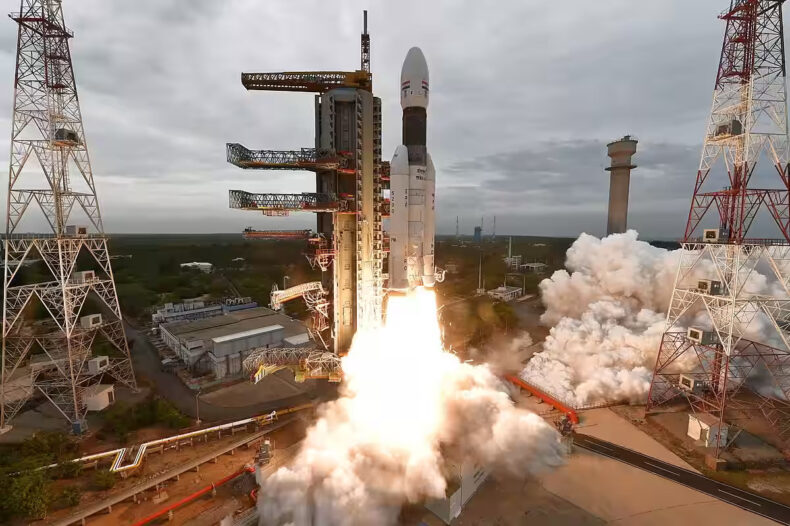On a bright Friday afternoon, history was made as the Indian Space Research Organisation (ISRO) successfully launched Chandrayaan-3, its highly anticipated third lunar exploration mission.
The Satish Dhawan Space Center in Sriharikota, Andhra Pradesh, India, witnessed a spectacle as the Launch Vehicle Mark-3 (LVM3) rocket carrying the Chandrayaan-3 spacecraft soared into the sky. This second attempt at a moon landing carries the dreams and aspirations of a nation that aims to cement its place among the elite few that have explored Earth’s celestial neighbor.
Table of Contents
ISRO and India Join the Elite Club
India’s ambitious mission, following the footsteps of Chandrayaan-2, is focused on showcasing its capabilities in lunar exploration. The mission aims to achieve significant milestones, including reaching the moon’s orbit, executing a soft landing using a lander, and deploying a rover to study the lunar surface.
With each step, India gets closer to joining an exclusive club of nations that have successfully landed on the moon, currently occupied by the United States, the former Soviet Union, and China.
An Orbital Journey: Chandrayaan-3’s Path to the Moon
Shortly after liftoff, approximately 16 minutes into the mission, Chandrayaan-3 successfully separated from the LVM3, entering Earth’s orbit. This crucial step initiated its fuel-efficient trajectory toward the moon.
Over the coming days and weeks, the spacecraft will undergo a series of orbital maneuvers, including elliptical cycles around Earth. The propulsion module will orbit the planet several times, with its closest point at 170 kilometers and its farthest at 36,500 kilometers, gradually propelling it closer to the lunar orbit.
ISRO’s relentless pursuit of innovation is evident in the technological advancements incorporated into Chandrayaan-3. The spacecraft is equipped with a new algorithm that estimates its speed in real-time during descent.
This cutting-edge software, a departure from Chandrayaan-2‘s static image interpretation, ensures precise navigation and landing.
Additionally, the rover, aptly named Pragyan, boasts its own solar array and advanced cameras to detect and avoid obstacles, allowing it to explore the lunar surface with precision.
How Did the Launch Become a Global Spectacle?
The momentous launch of Chandrayaan-3 captivated audiences worldwide, with the live event streamed on ISRO’s official website and YouTube channel.
The enthusiasm surrounding the mission extended far beyond India’s borders, resonating with leaders of Indian-origin start-ups and major corporations in Silicon Valley.
This successful lunar mission serves as a symbol of India’s technological prowess and its emergence as a global leader in critical aspects of the technology industry.
Bright Future in Space Exploration for India
If the remainder of the mission unfolds according to plan, India’s name will be etched alongside the pioneering nations that have achieved a soft landing on the moon.
The endeavor marks a significant milestone for ISRO and India’s space exploration program, propelling the nation’s aspirations of becoming a prominent player in low-cost space exploration.
As countries vie to establish a long-term presence on the moon, India’s success with Chandrayaan-3 will undoubtedly accelerate its ambitions and fuel further innovation in the field.
Towards New Frontiers: The Challenges Ahead
While India’s Chandrayaan-3 mission sets out to conquer new frontiers, it faces its fair share of challenges. Unlike previous successful landings near the moon’s equator, Chandrayaan-3 aims to reach the south pole, where landing conditions are more treacherous.
The limited sunlight and long shadows present unique obstacles, making a safe landing a formidable task. However, ISRO scientists have prepared diligently, equipping the lander named Vikram with strengthened legs to withstand a higher landing speed and widening the landing area to increase the mission’s chances of success.
As Chandrayaan-3 embarks on its lunar odyssey, the mission timeline is tightly knit. Assuming a successful touchdown on the moon, the rover Pragyan and the lander Vikram will operate for approximately one lunar day, equivalent to two weeks on Earth.
Equipped with state-of-the-art scientific instruments, the duo will conduct crucial analyses of the lunar soil, rocks, and chemical composition. While their survival beyond the lunar day is uncertain, the possibility of extended operations through innovative battery charging techniques keeps the hopes alive for further exploration.
With Chandrayaan-3’s journey to the moon now underway, we eagerly await the touchdown on the lunar surface, where India’s presence will mark a monumental achievement.
The question that remains is, what new discoveries and revelations await us on the moon’s enigmatic terrain?













